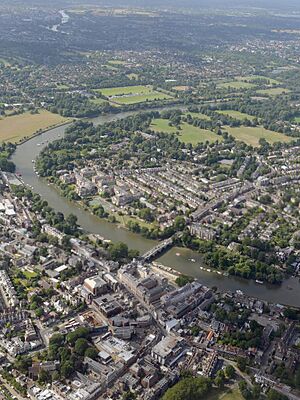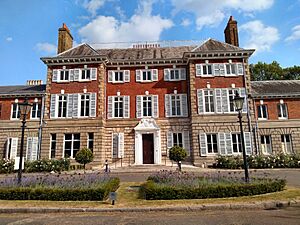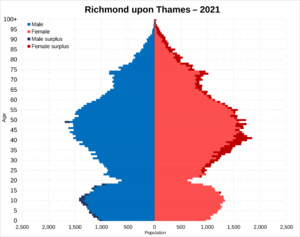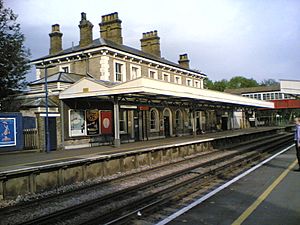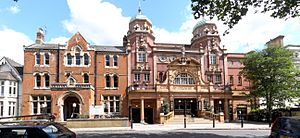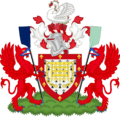London Borough of Richmond upon Thames facts for kids
Quick facts for kids
London Borough of Richmond upon Thames
|
|||
|---|---|---|---|
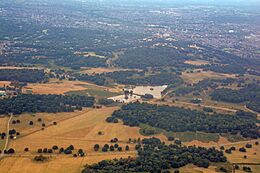
Richmond Park and the wider Richmond-upon-Thames from above
|
|||
|
|||
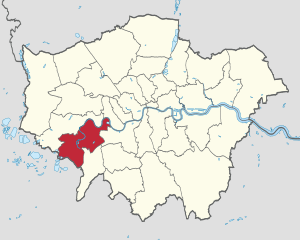
Richmond shown within Greater London
|
|||
| Sovereign state | United Kingdom | ||
| Constituent country | England | ||
| Region | London | ||
| Ceremonial county | Greater London | ||
| Created | 1 April 1965 | ||
| Admin HQ | Twickenham | ||
| Government | |||
| • Type | London borough council | ||
| • Body | Richmond upon Thames London Borough Council | ||
| Area | |||
| • Total | 22.17 sq mi (57.41 km2) | ||
| Area rank | 262nd (of 326) | ||
| Population
(2020)
|
|||
| • Total | 198,019 | ||
| • Rank | 94th (of 326) | ||
| • Density | 8,933.4/sq mi (3,449.21/km2) | ||
| Time zone | UTC (GMT) | ||
| • Summer (DST) | UTC+1 (BST) | ||
| Postcodes |
TW, SW, KT
|
||
| ISO 3166 code | GB-RIC | ||
| ONS code | 00BD | ||
| GSS code | E09000027 | ||
| Police | Metropolitan Police | ||
The London Borough of Richmond upon Thames is a cool area in southwest London, England. It's special because it's the only London borough that sits on both sides of the River Thames.
This borough was created in 1965. Three smaller local areas joined together to form it. Today, it's run by the Richmond upon Thames London Borough Council. Around 198,000 people live here. Some of the main towns and areas include Barnes, Kew, Richmond, and Twickenham.
Richmond upon Thames is home to Richmond Park, which is the biggest park in London. You can also find important places like the National Physical Laboratory and The National Archives here. Famous attractions like Kew Gardens, Hampton Court Palace, and Twickenham Stadium are also within its borders. These places attract many visitors from both the UK and other countries. In 2023, a study called it the "happiest place to live in Great Britain"! This was the first time a London borough got the top spot.
Contents
- History of Richmond upon Thames
- Exploring Richmond's Geography
- How Richmond is Governed
- People and Population (Demography)
- Getting Around Richmond (Transport)
- Learning in Richmond (Education)
- Sports and Fun Activities
- Arts and Culture in Richmond
- Twin Towns and Sister Cities
- Images for kids
- See also
History of Richmond upon Thames
There was a town called Richmond that became a borough way back in 1890. It grew bigger in 1892, adding places like Kew and Petersham. It grew again in 1933 to include Ham.
The current, larger London Borough of Richmond upon Thames was formed in 1965. This happened because of a law called the London Government Act 1963. It combined the old Richmond borough with two nearby areas: Municipal Borough of Barnes and Municipal Borough of Twickenham. Before this, Barnes and Richmond were in Surrey, and Twickenham was in Middlesex. All these areas became part of Greater London and formed one of the 32 London boroughs. The new borough was named 'Richmond upon Thames' to show it's different from the older Richmond borough. It's still the only London borough that crosses the River Thames.
Exploring Richmond's Geography
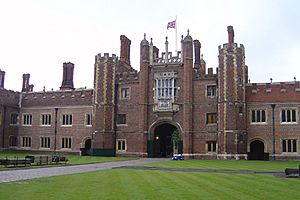
About half of the borough is made up of beautiful parkland. Some of the most famous parks include Richmond Park, Bushy Park, and Kew Gardens. There are over 100 parks and open spaces here. Plus, there are 21 miles (34 km) of riverfront along the Thames! A large part of the borough is also protected as part of the Metropolitan Green Belt.
Most of the other land is used for homes. Businesses in the area are mostly shops, property services, and professional services. Some parts of the borough, like Barnes and Richmond, have some of the highest house prices in Outer London.
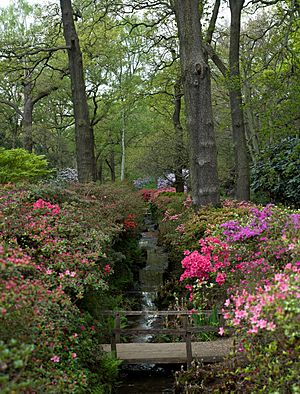
The borough is home to the National Physical Laboratory. It also has popular attractions like Hampton Court Palace, Twickenham Stadium, and the WWT London Wetlands Centre. These places bring in many visitors from all over the world.
The River Thames gets narrower as it flows into the borough. It also stops being tidal (meaning its water level doesn't change with the ocean tides) at Teddington Lock. The river mostly flows from south to north through more than half of the borough.

Many German businesses and people living in London are based in this borough. This is because the German School London (DSL) is located here.
Richmond upon Thames Climate
| Climate data for Kew Gardens (1991–2020) | |||||||||||||
|---|---|---|---|---|---|---|---|---|---|---|---|---|---|
| Month | Jan | Feb | Mar | Apr | May | Jun | Jul | Aug | Sep | Oct | Nov | Dec | Year |
| Mean daily maximum °C (°F) | 8.6 (47.5) |
9.2 (48.6) |
11.9 (53.4) |
15.1 (59.2) |
18.4 (65.1) |
21.4 (70.5) |
23.8 (74.8) |
23.4 (74.1) |
20.3 (68.5) |
16.0 (60.8) |
11.6 (52.9) |
8.9 (48.0) |
15.7 (60.3) |
| Mean daily minimum °C (°F) | 2.0 (35.6) |
2.0 (35.6) |
3.5 (38.3) |
5.1 (41.2) |
8.2 (46.8) |
11.0 (51.8) |
13.2 (55.8) |
13.0 (55.4) |
10.5 (50.9) |
7.8 (46.0) |
4.3 (39.7) |
2.3 (36.1) |
6.9 (44.4) |
| Average rainfall mm (inches) | 59.9 (2.36) |
45.4 (1.79) |
39.0 (1.54) |
43.6 (1.72) |
44.6 (1.76) |
49.7 (1.96) |
45.2 (1.78) |
55.1 (2.17) |
51.9 (2.04) |
67.9 (2.67) |
66.0 (2.60) |
59.2 (2.33) |
627.5 (24.70) |
| Average rainy days (≥ 1 mm) | 11.8 | 9.9 | 8.9 | 8.6 | 8.3 | 8.5 | 7.6 | 8.4 | 8.4 | 10.9 | 11.3 | 11.2 | 113.8 |
| Mean monthly sunshine hours | 60.2 | 80.7 | 128.0 | 181.0 | 213.4 | 209.8 | 221.9 | 206.5 | 152.0 | 117.4 | 69.7 | 52.7 | 1,693.2 |
| Source: Met Office | |||||||||||||
Neighbourhoods of Richmond upon Thames
The local council divides the borough into fourteen areas, or "villages." These areas don't always match the official political areas or postcode zones. There are four main post towns in the borough: Hampton, Richmond, Teddington, and Twickenham. Some parts of the borough are also covered by the London post town, like Barnes. While most addresses have TW postcodes, some have SW and KT postcodes.
| Neighbourhood or "village" | Associated postal districts | Associated political wards | Sub-areas |
|---|---|---|---|
| Barnes | London SW13 | Barnes; Mortlake and Barnes Common | Castelnau, Barnes Common, Barnes Bridge, Barnes Village |
| East Sheen | London SW14, London SW15, Richmond TW10 | East Sheen | Richmond Park |
| Ham and Petersham | Kingston KT2, Richmond TW10 | Ham, Petersham and Richmond Riverside | Ham, Petersham |
| Hampton | Hampton TW12, East Molesey KT8 | Hampton; Hampton North | |
| Hampton Hill | Teddington TW11, Hampton TW12 | Fulwell and Hampton Hill | Fulwell |
| Hampton Wick | Kingston KT1, Teddington TW11 | Hampton Wick | |
| Kew | Richmond TW9, Richmond TW10, London SW14 | Kew | Kew Green, Kew Bridge |
| Mortlake | London SW15, London SW14 | Mortlake and Barnes Common | Chiswick Bridge |
| North Twickenham and East Whitton | Twickenham TW1, Twickenham TW2, Hounslow TW3 | St Margarets and North Twickenham; Whitton | Cole Park, Stadium Village |
| Richmond and Richmond Hill | Richmond TW9, Richmond TW10 | South Richmond; North Richmond | |
| Strawberry Hill | Twickenham TW1 | South Twickenham; Teddington | |
| St Margarets and East Twickenham | Twickenham TW1, Twickenham TW2, Isleworth TW7 | St Margarets | St Margarets |
| Teddington | Teddington, TW11 | Teddington | Fulwell |
| Twickenham | Twickenham TW1, Twickenham TW2 | Twickenham Riverside; South Twickenham; West Twickenham | Twickenham Green, Fulwell |
| Whitton and Heathfield | Twickenham TW2, Whitton, Hounslow TW3 & TW4, Isleworth TW7 | Whitton; Heathfield | Whitton, Heathfield |

How Richmond is Governed
The local government for the borough is the Richmond upon Thames London Borough Council. The council members meet at York House in Twickenham. Their main offices are next door at the Civic Centre.
Representing Richmond in London
Since 2000, for elections to the London Assembly, the borough is part of the South West area. This area is currently represented by Gareth Roberts. The London Assembly helps make decisions for all of London.
Richmond's Parliament Members
The borough is divided into three areas for electing Members of Parliament (MPs). MPs represent the people in the UK Parliament.
- The area south of the River Thames is part of the Richmond Park constituency. This area also includes some parts of the nearby borough of Kingston.
- Most of the area north of the river forms the Twickenham constituency.
- Since the 2024 general election, the northernmost part of the borough, Whitton, is now part of the Brentford and Isleworth constituency. The rest of this constituency is in the London Borough of Hounslow.
Before 2024, the entire area north of the Thames was part of the Twickenham constituency since 1997.
| Constituency | Member of Parliament | Political affiliation | Elected |
|---|---|---|---|
| Richmond Park | Sarah Olney | Liberal Democrats | 2019 |
| Twickenham | Munira Wilson | Liberal Democrats | 2019 |
| Brentford and Isleworth | Ruth Cadbury | Labour Party | 2015 |
People and Population (Demography)
In 2006, a study found that Richmond upon Thames had the best quality of life in London. It was also among the top areas in the whole country.
Richmond is known as one of London's wealthiest boroughs. It has the lowest rates of poverty, child poverty, and low pay compared to other London boroughs. It also has fewer adults without higher qualifications. However, like all places, it has some areas with more challenges.
Ethnic Diversity in Richmond
| Ethnic group | Year | |||||||||||
|---|---|---|---|---|---|---|---|---|---|---|---|---|
| 1971 estimations | 1981 estimations | 1991 census | 2001 census | 2011 census | 2021 census | |||||||
| Number | % | Number | % | Number | % | Number | % | Number | % | Number | % | |
| White: Total | – | 97.8% | 148,135 | 95.5% | 151,919 | 94.5% | 156,785 | 91% | 160,725 | 85.5% | 157,111 | 80.4% |
| White: British | – | – | – | – | – | – | 135,665 | 78.8% | 133,582 | 71.4% | 123,093 | 63.0% |
| White: Irish | – | – | – | – | – | – | 4,805 | % | 4,766 | 2.5% | 4,866 | 2.5% |
| White: Gypsy or Irish Traveller | – | – | – | – | – | – | – | – | 95 | 0.05% | 85 | 0.0% |
| White: Roma | – | – | – | – | – | – | – | – | – | – | 400 | 0.2% |
| White: Other | – | – | – | – | – | – | 16,325 | 9.5% | 22,282 | 11.9% | 28,667 | 14.7% |
| Black or Black British: Total | – | – | – | – | 1,221 | 0.75% | 1,614 | 0.93% | 2,816 | 1.3% | 3,687 | 2% |
| Black or Black British: African | – | – | – | – | 355 | 829 | % | 1,643 | 0.8% | 2,260 | 1.2% | |
| Black or Black British: Caribbean | – | – | – | – | 553 | 643 | % | 840 | 0.4% | 936 | 0.5% | |
| Black or Black British: Other Black | – | – | – | – | 313 | 124 | % | 333 | 0.1% | 491 | 0.3% | |
| Asian or Asian British: Total | – | – | – | – | 5,711 | 3.5% | 7,968 | 4.6% | 13,607 | 7.0% | 17,467 | 9% |
| Asian or Asian British: Indian | – | – | – | – | 2622 | 1.63% | 4,232 | % | 5,202 | 2.7% | 7236 | 3.7% |
| Asian or Asian British: Pakistani | – | – | – | – | 353 | 664 | % | 1,163 | 0.6% | 1749 | 0.9% | |
| Asian or Asian British: Bangladeshi | – | – | – | – | 322 | 662 | % | 867 | 0.4% | 916 | 0.5% | |
| Asian or Asian British: Chinese | – | – | – | – | 866 | 1,299 | % | 1,753 | 0.9% | 2777 | 1.4% | |
| Asian or Asian British: Other Asian | – | – | – | – | 1548 | 0.96% | 1,151 | % | 4,622 | 2.4% | 4789 | 2.5% |
| Mixed or British Mixed: Total | – | – | – | – | – | – | 3,797 | 2.2% | 6,780 | 3.4% | 10,662 | 5.4% |
| Mixed: White and Black Caribbean | – | – | – | – | – | – | 670 | % | 1,250 | 0.6% | 1654 | 0.8% |
| Mixed: White and Black African | – | – | – | – | – | – | 443 | % | 731 | 0.3% | 1205 | 0.6% |
| Mixed: White and Asian | – | – | – | – | – | – | 1,530 | % | 2,857 | 1.5% | 4238 | 2.2% |
| Mixed: Other Mixed | – | – | – | – | – | – | 1,154 | % | 1,942 | 1.0% | 3565 | 1.8% |
| Other: Total | – | – | – | – | 1881 | 1.17% | 2,171 | 1.25% | 3,062 | 1.6% | 6,350 | 3.3% |
| Other: Arab | – | – | – | – | – | – | – | – | 1,172 | 0.6% | 1,721 | 0.9% |
| Other: Any other ethnic group | – | – | – | – | 1881 | 1.17% | 2,171 | 1.25% | 1,890 | 1.0% | 4,629 | 2.4% |
| Ethnic minority: Total | – | 2.2% | 7,026 | 4.5% | 8,813 | 5.42% | 15,550 | 9% | 26,265 | 14.2% | 38,166 | 19.6% |
| Total | – | 100% | 155,161 | 100% | 160,732 | 100% | 172,335 | 100.00% | 186,990 | 100.00% | 195,277 | 100% |
| Population census | ||
|---|---|---|
| Year | Pop. | ±% |
| 1801 | 14,560 | — |
| 1811 | 16,748 | +15.0% |
| 1821 | 19,908 | +18.9% |
| 1831 | 22,752 | +14.3% |
| 1841 | 25,224 | +10.9% |
| 1851 | 28,769 | +14.1% |
| 1861 | 40,194 | +39.7% |
| 1871 | 51,619 | +28.4% |
| 1881 | 63,045 | +22.1% |
| 1891 | 79,854 | +26.7% |
| 1901 | 103,720 | +29.9% |
| 1911 | 134,729 | +29.9% |
| 1921 | 152,968 | +13.5% |
| 1931 | 173,683 | +13.5% |
| 1941 | 187,420 | +7.9% |
| 1951 | 202,246 | +7.9% |
| 1961 | 187,923 | −7.1% |
| 1971 | 174,640 | −7.1% |
| 1981 | 157,298 | −9.9% |
| 1991 | 164,235 | +4.4% |
| 2001 | 172,327 | +4.9% |
| 2011 | 186,990 | +8.5% |
| 2021 | 195,200 | +4.4% |
| Note: | ||
Richmond's Coat of Arms
The borough's history is shown in its coat of arms, which was officially given in 1966. It features a golden portcullis (a gate) on a white background, surrounded by a red border with eight golden fleur-de-lis symbols.
The top part, called the crest, shows a white swan rising up from a red crown. The swan holds a branch of red climbing roses. The swan represents the River Thames, which flows through the borough.
The supporters on either side are red griffins. Each griffin holds an oar. One oar has a dark blue blade, and the other has a light blue blade. These oars represent the famous Boat Race between Oxford and Cambridge universities, which finishes in Mortlake, within the borough. The colours red, gold, and white (ermine) are royal colours, showing Richmond's royal past.
Getting Around Richmond (Transport)
Air Travel
London Heathrow Airport is not far away, located just west of the borough.
Bus Services
Many Transport for London bus routes serve the borough, making it easy to get around.
Train Services
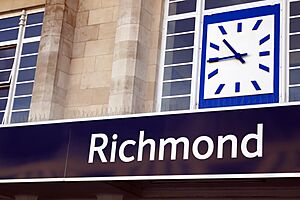
The borough is connected to central London and Reading by National Rail trains run by South Western Railway.
Richmond upon Thames doesn't have as many London Underground (Tube) stations as some other parts of West London. Two stations, Richmond and Kew Gardens station, are served by the District line. Both are also served by London Overground trains on the North London line, which links Richmond to North London and Stratford. The southwestern part of the borough, like Twickenham, mostly uses suburban railway services.
Other train stations in the borough include: Barnes, Barnes Bridge, Fulwell, Hampton, Hampton Wick, Mortlake, North Sheen, St Margarets, Strawberry Hill, Teddington, Twickenham, and Whitton.
Learning in Richmond (Education)
The Richmond upon Thames College opened in 1977. It was the first "tertiary college" in Greater London. This meant that almost all studies for 16-19 year olds happened at this college. This system changed in 2012 when the council allowed schools to create their own sixth forms. The council also approved the creation of a Catholic secondary school for the first time in the borough.
Sports and Fun Activities
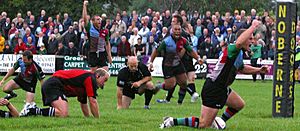
The borough has a local football club called Hampton & Richmond Borough F.C., who play at Beveree Stadium. Twickenham Stadium is a famous place for international rugby games. The Twickenham Stoop is home to the Harlequins Rugby Team.
Richmond Rugby Club also plays here and shares its grounds with London Scottish F.C.. There's a big youth rugby group called Richmond Minis, and the Richmond Heavies organize games for older players.
Cricket is played in many places, including Ham Common, Richmond Green, and Kew Green.
Since the River Thames flows through the borough, there are many sailing and rowing clubs along its banks. The Richmond Canoe Club is located near Richmond Bridge.
There's also a lot of horse riding activity. This includes the Horse Rangers Association and Ham Polo Club.
Richmond has swimming pools called Pools on the Park near the town centre. They have an outdoor pool that's open in the summer. There's also a heated outdoor pool in Hampton.
Arts and Culture in Richmond
The Twickenham Museum is a museum run by volunteers. It's across from St Mary's parish church.
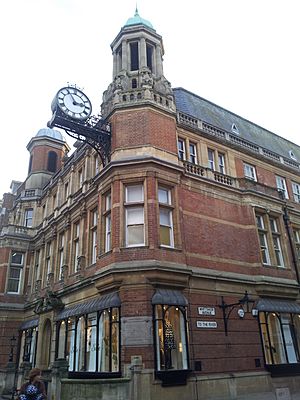
The Museum of Richmond is in Richmond's Old Town Hall, near Richmond Bridge. It shows the history of Richmond, Ham, Petersham, and Kew. They have changing exhibitions, educational activities, and events that cover the whole borough. Some cool things to see include 16th-century glass from Richmond Palace and a painting called The Terrace and View from Richmond Hill, Surrey by Dutch artist Leonard Knyff.
Orleans House Gallery in Twickenham displays art from the London Borough of Richmond upon Thames' collection. This includes a portrait of James Johnston and paintings of Orleans House. It also has the Burton Collection, which includes art and items from the explorer Richard Francis Burton. The gallery also offers art workshops for different ages.
Garrick's Temple to Shakespeare in Hampton has a free Shakespeare exhibition from April to October. It also hosts summer drama, music, and other exhibitions.
Richmond has two theatres. The Richmond Theatre is a beautiful Victorian building. It hosts plays and musicals by professional touring companies. Sometimes, you can even see shows before they go to London's West End. They also have a popular Christmas pantomime every year.
Near Richmond railway station is the Orange Tree Theatre. It started in 1971 in a room above a pub. As it became more popular, it moved to a converted primary school in 1991. This theatre has 172 seats and is known for its "theatre in the round" style, where the audience sits all around the stage. It's famous for showing new plays and bringing back forgotten old ones.
The performance group Richmond Opera practices regularly at The Vineyard Centre.
The Cabbage Patch pub near Twickenham railway station has been a regular place for live music on Sunday nights since 1983, organized by TwickFolk.
In 2015, Barnes, London became home to London's biggest children's book event, the Barnes Children's Literature Festival. It's now the second largest in Europe!
Twin Towns and Sister Cities
Richmond upon Thames has special partnerships with other towns around the world. These are called "twin towns" or "sister cities":
 Fontainebleau, France (since 1977)
Fontainebleau, France (since 1977) Konstanz, Germany (since 1983)
Konstanz, Germany (since 1983) Richmond, Virginia, United States (since 1980)
Richmond, Virginia, United States (since 1980)
Images for kids
-
Richmond Park and the wider Richmond-upon-Thames from above
-
Richmond shown within Greater London
See also
 In Spanish: Richmond upon Thames para niños
In Spanish: Richmond upon Thames para niños



